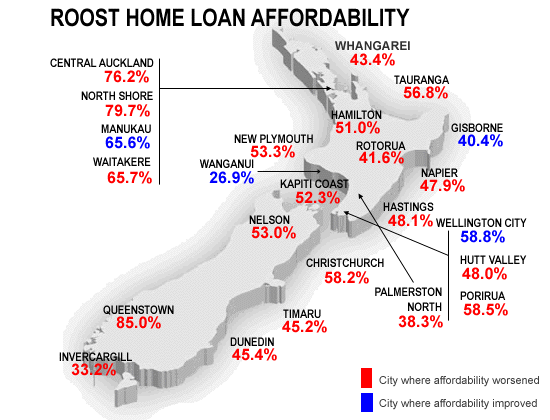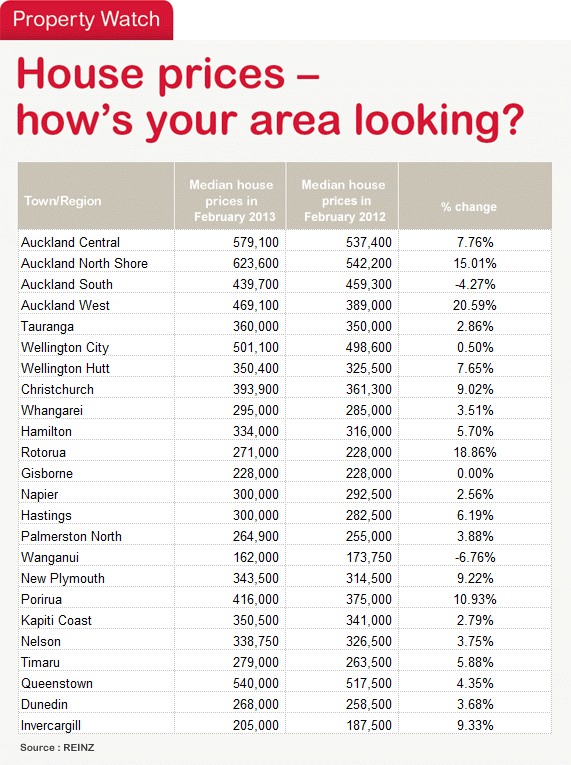
Home loan affordability worsened in February to near its worst levels in two years after the national median house price surged to near a record high.
A slight fall in some interest rates and a marginal rise in incomes was not enough to offset the rise in house prices.
New Zealand’s median house price rose to NZ$382,000 in February from NZ$370,000 in January and was just below a record high of NZ$389,000 set in December.
A surge in house prices in Auckland and Christchurch over the last year because of a shortage of supply is now beginning to leach out into those provincial areas where economic activity is stronger and emigration is slower. A relaxation of lending standards and more heated competition between banks to lend at record low interest rates has also helped boost housing market activity.
Nationally, affordability worsened by 1.6 percentage points in February from January, which meant it took 54.9% of a single median income after tax to afford an 80% mortgage on a median house in February, according to the Roost home loan affordability report released today.
“Market activity heated up again through the long hot summer. First home buyers and investors have been busy working with their brokers to get the best deal out of the intense competition between the banks,” said Colleen Dennehy, a spokeswoman for Roost, which sponsors the Home Loan Affordability report series from Interest.co.nz.
Affordability worsened in most of Auckland, Northland, Wellington, Rotorua and Porirua because of big rises in median house prices. Affordability only improved in South Auckland and Wanganui where median house prices fell.
Average advertised floating mortgage rates were flat in February, while advertised six month and 1 year mortgage rates have fallen over the last year and were down slightly in February.
For first home buyers – which in this Roost index are defined as a 25-29 year old who buys a first quartile home – there was also a deterioration, particularly in the biggest cities. However, apart from Auckland, Queenstown and Canterbury, it takes around 20-40% of after tax pay to afford an 80% mortgage on a lower quartile priced house. That percentage rises however to 66%, 67% and 47% respectively in those three most expensive areas.
Any level over 40% is considered unaffordable, whereas any level closer to 30% has coincided with increased buyer demand in the past.
For working households, the situation is similar although bringing two incomes to the job of paying for a mortgage makes life considerably easier. A household with two incomes would typically have had to use 36.2% of their after tax pay in February to service the mortgage on a median priced house. This is up from 35.1% the previous month.
On this basis, most
For households in the 25-29 age group (which is assumed to have no children), affordability also improved, with 22.3% of after tax income in households with two incomes required to service the debt, up from 21.8% the previous month.
Any level over 30% is considered unaffordable in the longer term for such a household, while any level closer to 20% is seen as attractive and coinciding with strong demand.
First home buyer household affordability is measured by calculating the proportion of after tax pay needed by two young median income earners to service an 80% home loan on a first quartile priced house.

-----------------------------------------------------------------------------------------------
Mortgage choices involve making a significant financial decision so it often pays to get professional advice. A Roost mortgage broker can be contacted by following this link »
-----------------------------------------------------------------------------------------------
No chart with that title exists.
Full regional reports are available below:
7 Comments
Kimy, sound like you need a new architect, drainage engineer, surveyor. If they didn't know about the Unitary Plan, they need to be sacked...
Just curious - when you say 'architect' do you mean an actual registered architect or do you actually mean 'architectural designer' or 'licensed building practitioner' or something else?
Is not true affordability a product of income less outgoings? If so then le kimy is on the right track. Sorting out insulation and choice of an efficient heating system will reduce expenses (at Homestar we reckon payback times on a 'typical' profile about 5 years). A bit of smart tax accounting would presumably ace the deal too. If anyone is interested please feel free to contact me for independent studies on this for new builds.
"The Australian housing market has been described as one of the last untouched bubbles since the 2008 financial crisis. It did not crack in 2008 due to the massive stimulus undertaken within the Asian region (China injected 20% of GDP into it's economy, Australia new home buyer stimulus, Japan on going stimulus). The current state of the Aussie housing bubble is that a 'Joe Blogs' house sells for 18x the average wage (and that is not including the outrageous house prices in Sydney). The private debt behind the Aussie residential property market is a massive 140% of GDP (seeSteve Keen chart). Therefore if the residential housing market pops only 20% the effect on the Australian economy would be equal to a depression (ie a drop of GDP by 10%)".
http://www.marketoracle.co.uk/Article39749.html
Kimy, with 40,000 New Zealanders deserting New Zealand every year for Australia, who is propping up the New Zealand property market?
Truth is both property markets are facing the wall...meanwhile the cheaper easier credit is spewing from the banks....and Wheeler awaits their decision on what the RBNZ may do in a late effort to hold back the bubble....
Wolly----the general perception amongst posters on this site that the Australian real-estate sector is generally heading over a cliff does not entirely dove tail with the reality—mortgage punters ahead $160 billion with payments would indicate aussies have pulled their heads in with regard to debt---



We welcome your comments below. If you are not already registered, please register to comment.
Remember we welcome robust, respectful and insightful debate. We don't welcome abusive or defamatory comments and will de-register those repeatedly making such comments. Our current comment policy is here.